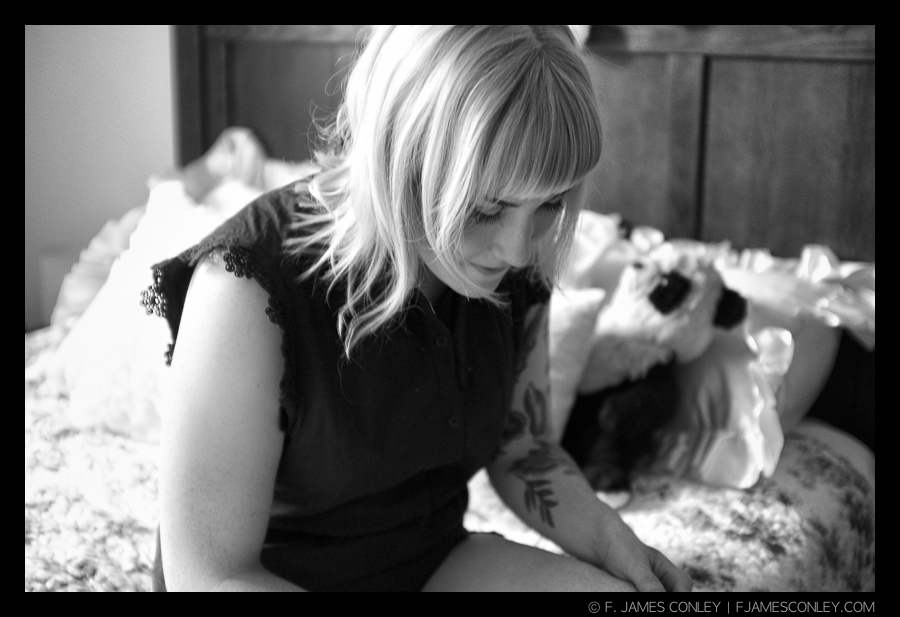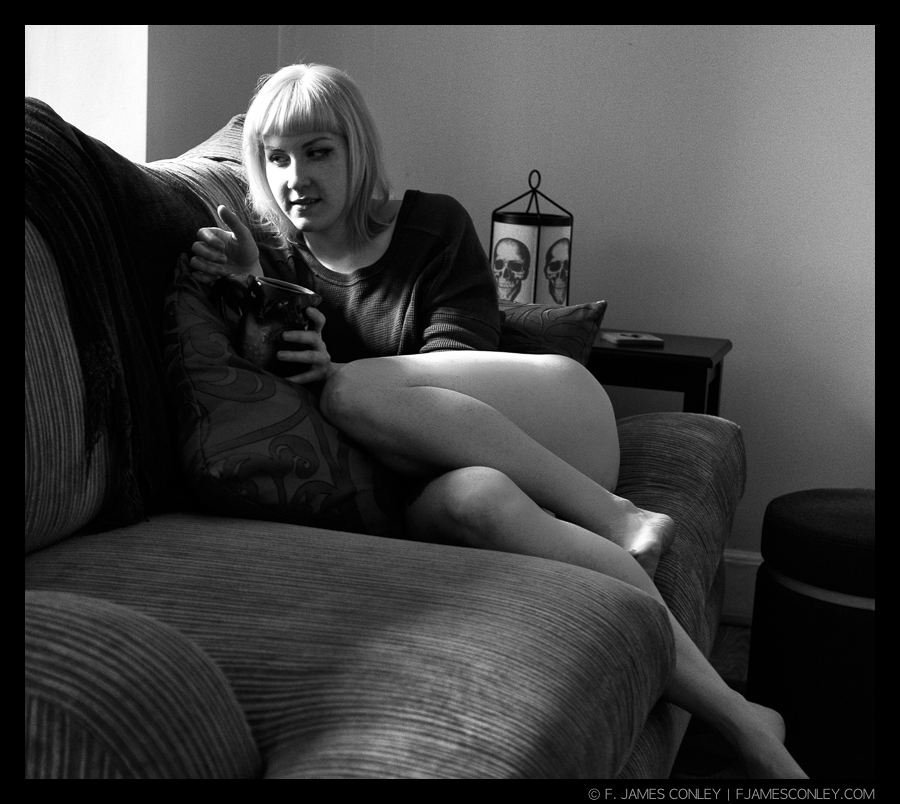I get depressed every time I see a headshot. Our sense of the "portrait" has been degraded to the most superficial and meaningless, and the headshot has now been consecrated as the most important popular image: the "selfie." This is bad enough. But when photographers succumb to this popular misconception as a standard, it's easy to lose hope.
Like most things, a large part of the problem is the language. When a photographer is asked to make a "portrait" the photographer of course relies upon the common definition, which is informed by the popular language. This is the start of the problem, but photographers often make it worse with their conception of their "subject."
Photographers commonly talk about the "subject" of a portrait, just as we would talk about the "subject" of a product illustration. By commoditizing the object of our attention, we also limit the ways in which we think about it. When we treat a person as a "subject," we end up thinking of ourselves (as photographers) as the dynamic part of the process, and the "subject" as the static part. And so we sit the "subject" in a chair in a studio and drag lights around the "subject," all the while repositioning things for our own convenience. We pose the "subject" to fulfill our conception, in the same way that we would light a plate of food for an illustration, adjusting this bit here or there, modifying this thing or that, as we inspect the "subject" from different angles. And in the end, what we wind up with—no matter how many stylists are involved, or how many lights are involved—is at best an amazing bit of product photography which happens to have a person in it. (Which, of course, then gets post-processed until it appears that Mattel was involved in the creation.) This, I suggest, is not portraiture, and no "subject" should accept such an image.
The underlying concept of a "portrait" is to feature a single subject. The idea is to reveal that person's likeness, to be sure, but also to give the spectator a sense of the subject's personality: what that person cares about, how that person behaves, a clue as to what it is to know that person. In paintings, this is done by supplying a plethora of information in the setting and the details of the background—things which don't exist in the photographer's studio backdrop. But it's worse, still.
The artist and her octopus painting.
The amazing product of art is also the biggest danger in photography: all art is the expression of the artist's surreal thought. Whereas a painter may have months to allow those surreal thoughts to come to the surface and be expressed on canvas, the photographer works in thousandths of a second. But in the creation of art, the timeframe does not matter. What we think as photographers comes out in the work just as much as what the painter thinks comes out on the canvas.
The problem which disguises this significant process, of course, is that it doesn't take months to make a photograph. The act of pressing the button happens rather quickly. The speed with which we can take a photograph distorts the expectation for how long the artistic process takes.
This is another problem with language. "Taking a picture" is not the same as "making an image." A—probably apocryphal—story about Picasso illustrates the point. The story goes that Picasso was doing street sketches when he was approached by a woman who asked for a portrait. He obliged, drawing her portrait in a few minutes. She asked how much. He replied with a handsome sum. The woman protested saying that the sketch only took a matter of minutes. Picasso replied, "No. It took me a lifetime."
The point, of course, is that artistic skill is not reflected in the time it takes to produce. Likewise, the time it takes to make an image does not reflect how long it takes for the surreal ideas underlying the image to form, much less the challenge of waiting for a natural moment which reflects those surreal ideas.
At the extreme are those persons we intimately know over a course of time. These can be people in our own lives, or people with whom we spend substantial time. Famously, for example, Cartier-Bresson lived with Matisse over four months before producing his famous portrait of the painter. But with each individual you photograph, no matter how deep or shallow your knowledge, how shallow or broad your experience, every resulting image is a representation of that relationship. There's no way to distort or hide this relationship. The photograph is proof of the photographer's thoughts.
And so, when we make a portrait we are representing our relationship with the person in the image. The superficial headshot shows that the relationship was superficial, which is insulting not only to the person in the image, but also sells short the photographer as an artist who has a valid perspective to share.
These thoughts were on my mind when I spent a morning with my friend Bridget. She wanted some "portraits." I could have packed up the light stands, the White Lightning, the softbox, some umbrellas, some strobes and radio triggers and gels, a variety of prime lenses . . . . But instead I grabbed the X100s and the TCL, and went over for coffee. Instead of telling her where to sit and how to pose, instead of imposing my view on her, I took the perspective of an observer and considered how my knowledge about Bridget might visually translate. The only light was that in which she lives. The only poses were those which she naturally makes as a person. The only visual perspective was that which could be had by anyone spending time with her—allowing the spectator to participate in the moment. And the only post-processing was that which translated the moment I captured into one which best matched my visual perception at the time it was made. (Using the X100s as the Fuji Monochrom means very little post-processing indeed.)



By no means does this collection of images capture the entirety of who Bridget is as a person. However, I think this set does capture how she chose to present herself to me within the context of our relationship as friends. She's a complex person, both introvert and extrovert, both shy and expressive. Much of her personality is at odds with itself, which brings a lot of energy into the art she creates. These are the features that inform the surreal thoughts I have about her as a person, and these are the ones I see reflected in the images—features which even the most amazing of headshots could never capture.
What I seek to capture in any portrait I make is how the person chooses to present to me. For me, a successful image is one which allows a spectator to see the person as I do—to see the evidence of my surreal thoughts. My goal is always to be as true to the subject as far as I can. But this is a process that can't be done without context. Sitting someone down in a chair in my studio and dragging lights around them may result in a technically fine photograph, but it will be devoid of personality, humanness, and meaning. When given the choice, I prefer the approach I took with Bridget: one camera, a 50mm lens, available light, and the opportunity to allow others to see the person in my portraits in a way that not only accurately reflects my thoughts, but shows that those thoughts are built upon something meaningful which requires mutual respect.
It's a luxury and a blessing to be able to make a portrait. To preserve its significance and meaning, and to open up the photographer's thinking in how to approach each portrait, I suggest it's important to change the language we use to describe it: a portrait is set of images which gives the spectator an understanding of an individual, the personal environment, and the relationship between that individual and the photographer. A headshot in a studio is . . . well, just a headshot. Let's not degrade the purpose or function of either by conflating the language.
I further suggest that the next time you set out to make a portrait, spend more time getting to know the person you intend to photograph and less time worried about settings, lighting, makeup, and hair. I can guarantee that both of you will like the images much more than any headshot.